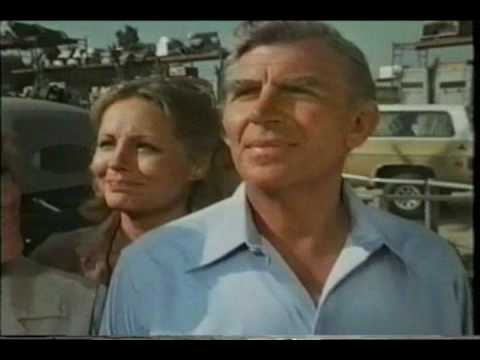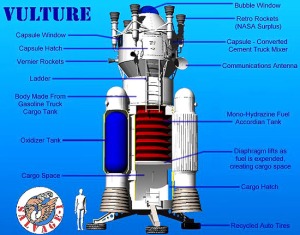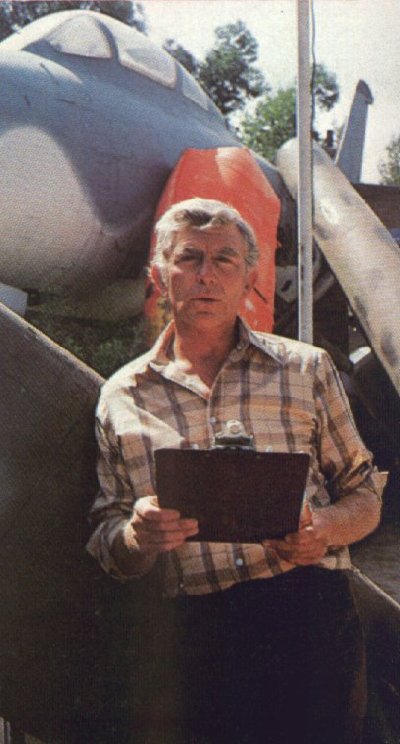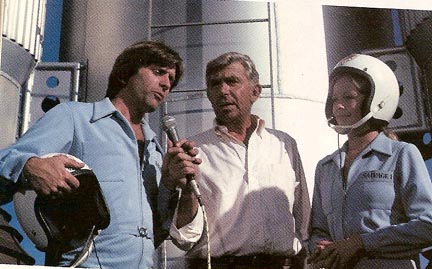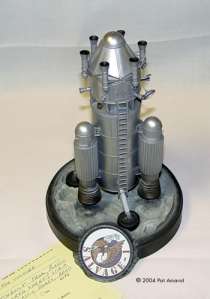There’s a truism about Hollywood that goes something like this: You can have it good, you can have it fast, and you can have it cheap. But you can only get two out of three.
That sounds like a recipe for junk television, especially when networks would like to have things cheap and fast first, and any quality that still exists as part of the final production is almost by accident. Of course, sometimes, you just need to figure out how to get someone to actually WANT to see your junk, to sell it properly, with a big idea that would gloss over some of the little faults. And here’s a big idea: a junkman with a dream….
“I want to build a ship, fly to the moon, salvage all the NASA stuff up there, bring it back to the earth, and sell it.”
–Harry Broderick (Andy Griffith)
In January of 1979, ABC premiered a TV-movie called Salvage. It detailed the rather fantastical tale of that “junkman with a dream”, Harry Broderick (played by beloved actor Andy Griffith). Harry’s dream, as you can see from the quote above, was rather far-fetched, but he was determined. Gaining the assistance of former astronaut Skip Carmichael (Joel Higgins) and fuel/tech expert Melanie Slozar (Trish Stewart), these three went about building a spaceship in a junkyard, traveling into space, collecting NASA’s leftovers, and returning safely home again (with a few dramatic complications along the way). Sounds ridiculous, doesn’t it?
It found a terrific tone between some obvious comedy moments and fun action-adventure drama, and although the actual science was…well…crap, it was dressed up in enough psuedo-realistic explanation that it was easy for the audience to just suspend their disbelief and take the story for exactly what it was: pure fun. The suits at ABC knew that they had a potential winner on their hands when they saw the pilot, and decided at once (before it aired) that the slightly renamed Salvage-1 would go to series. Oh, and by the way, our current schedule is bombing, and we want it for summer, shortly after the pilot movie. And can you get started filming yesterday?
ABC ordered 12 episodes (almost immediately, in TV terms), and then summer suddenly turned into “late January”, making immediately even shorter. Co-creator Mike Lloyd Ross was originally a Navy engineer, who brought the concept of the original pilot movie to producer Harve Bennett (best known as the man who killed off Mr. Spock a few years later in Star Trek II: The Wrath of Khan). Ross was not an experienced TV person, but after the studio green-lighted the series, went on to become the supervising producer for the first few episodes. Having to put together a writing and production staff in a hurry, with no experience, was only one of the tasks necessary for the show.
The series was difficult to write for because it wasn’t a “franchise” show (like a traditional cop/private eye, doctor, or lawyer show), where potential cases (and storylines) simply walked in the door. You really couldn’t just take an idea for a different show that was lying around and craft it for Salvage-1. It didn’t work that way, not when your characters main mode of transportation was a homemade rocket ship! Unless you count the sitcom Sanford and Son, there had never been a show about a junkman before, let alone one who built a rocket to the moon. We were in uncharted territory here, with unproven production people.
Fortunately, we had Andy Griffith. A television veteran (and a veritable legend in the business even then), Griffith had the talent and ability to make even poor scripts watchable, with his easygoing charm and likable manner. Adding in Joel Higgins (who would later go on to a successful run as the dad in Silver Spoons with Rick Schroder) as the young astronaut Skip, gave the series its handsome action figure, with occasional romantic elements with the lady guest of the week. Trish Stewart, as the tech expert Melanie, got stuck with much of the expository technobabble, but made the most of it and came off as spirited, attractive, and always ready for the next adventure, wherever it may be. Trish talks about trying to work under the production time pressure:
“Last night, we were all standing around trying to film a scene that was very static. Andy is just supposed to hand out mail–very static. But now, instead of that, when Andy comes in, I’m going to be doing yoga, and Joel is going to be playing the guitar–so that we are active and not static. We three actors worked that out together. If the script just doesn’t track, if it doesn’t work, we all sit down and try to work out some hook, some joke, that will pull it together. It’s like this all the time. We’re always working to improve the show. It’s not that we get bad scripts, it’s that everything has been so rushed all season. We did the pilot, and then a week later got the go-ahead for the show. They just didn’t have time to get those scripts together. They’re still working on the scripts while we’re shooting it.”
And yet, with all that rush and potential for disaster, Salvage-1 actually works, at least most of the time. Whether it’s the charm of the lead characters, or the pure quirkiness of the premise, or just the wide variety of possibilities that suddenly become fodder for episodes, the show ends up as enjoyable television, and is remembered fondly.
The faux science on the show wasn’t necessarily because of any hesitancy on the part of the production staff to be scientifically accurate (Isaac Asimov was a scientific advisor, at least on the pilot), but more because of the production realities of weekly television. You simply couldn’t afford to launch and land your own rocket ship every week, unless you fudged the science more than a bit.
In order to save time and money (and prevent the production company from falling farther behind than they already were), the pilot established that the “Vulture” used the “translinear vector principle” of constant, slow acceleration to reach escape velocity. What this really means is that you could just put the ship on a crane and film it, slowly, inching upward (or downward, for landing) and not have to mess with the expense and time of NASA type explosive launches that were just too prohibitive for filming. Believe it or not, the scientific basis of the “translinear vector principle” is sound, but there just isn’t any type of fuel practical for such a venture, so the producers simply made one up.
Then again, we can’t just go to the moon every week….
“Once you have been to the moon, some astronauts say, everything afterward is a letdown. That should have provided a clue to the makers of this ABC adventure series.”
–TV Guide critic Robert Mackenzie
So, what do you do for an encore? Yes, there was a running gag, set up at the end of the pilot, about moving an iceberg to the coast of California to provide water during a drought. But that would cost a bundle to shoot, let alone the logistical problems involved with the SFX, and remember, we’re in a hurry here, people! Oh, and don’t spend too much money while you’re at it….
Surprisingly, there were a lot of alternatives. A treasure map hidden in a classic car that might lead to a buried stash of Conquistador gold, a long-lost WWII bomber with personal memories for Harry, a spooky haunted house story, and another about a bomb shelter style house that becomes a potential death trap. You never knew what the team was going to face next, and that was part of the charm of the series. It also meant different sets, or locations, every week. So even if you’re going to do a “bottle show” on standing sets to save money, when your standing sets include a rocket ship, you’re going to have to have special effects and blow the budget anyway.
Somehow, those first 12 episodes were finished, and aired on ABC from January through May of 1979. When ABC announced their schedule for that fall, Salvage-1 was nowhere to be seen, and many thought the show had been canceled. ABC ended up ordering 7 more episodes, intending to use it as a mid-season replacement again. Because the show got a late order, the production team was once more trying to do the impossible, cheaply, and by yesterday. ABC’s first failure of the season happened quickly, meaning that the two-part “Hard Water” episode (the aforementioned iceberg story) was pushed forward, even though it was actually the last story shot. It aired on consecutive Sunday nights in November of that year, against #1 show 60 Minutes. Although 4 other episodes were in the can, ABC grounded the “Vulture” and ended Salvage-1, stopping filming as fast as they had begun it.
ANDY GRIFFITH (Harry Broderick) is one of the few who can honestly be called a legend of television. After starring in the eponymous Andy Griffith Show from 1960-68, he guested on numerous series until returning to regular TV with Salvage-1. From 1986-1995 he played the lead in the series Matlock, playing a sharp-minded lawyer with a laid-back southern manner. He has appeared in selected projects since, including the movie Waitress and, of all things, a Brad Paisley country music video called Waiting on a Woman (and believe me, for a music video, the performance is outstanding).
JOEL HIGGINS (Skip Carmichael) started in soap operas, appearing on both Search for Tomorrow and One Life to Live. After piloting the “Vulture”, Joel starred in the short-lived series Best of the West (with Meeno Peluce from Voyagers!) and followed that with his best known role, playing Edward Stratton III for five years on Silver Spoons. Joel is also an accomplished singer/songwriter, and has written a number of advertising jingles, including for M&M’s and Kool-Aid. Most recently, he wrote the music/lyrics and directed the musical stage adaptation of cult western movie Johnny Guitar, which won Best Off-Broadway Musical for 2004.
TRISH STEWART (Melanie Slozar) studied at the Sorbonne in Paris during the 60’s, and after a brief career as an airline hostess, went into acting. In 1973 she created the part of Chris Brooks Foster on The Young and the Restless, as part of the original cast, and stayed with the show for five years before landing (literally) the “Vulture” in Salvage-1. After a few more guest star parts in the following couple of years, she returned briefly to Y&R in 1984 before she left the business and returned to her home in the midwest.
And then, of course, there’s the “Vulture”. One of the most well-remembered and distinctive spaceships ever created, it’s probably the iconic image from the show. And although it was never officially released, the Estes model kit company had prepared designs of the “Vulture” for the home hobby market, so you too could put together your own “junkyard spaceship”. Some fans made resin kits (such as the picture on the right), but these unlicensed products are no longer available. Those willing to settle for paper modeling (even though it’s still a bit elaborate) can download a file that will give you the specifics to do so. Blueprints (done with AutoCad, no less) are here, but if you REALLY want to play SFX wizard and have the “Vulture” fly in your own show, there’s a CGI version that, given the right programs, you can download and use to create your own visual effects. (I told you this show was fondly remembered, and the amount of work some people have done because of it is truly amazing.)
–
The series ran for a total of 14 aired episodes, plus the 2-hour original pilot movie. There were four episodes that were made and never shown on the ABC network run, but aired in repeats on the Sci-Fi Channel and overseas. There is, as yet, no DVD available, although one has been rumored for quite a while, due to the fondness with which the show is remembered and the longevity of star Andy Griffith. Multiple scenes are available on YouTube. Actor Peter Brown had a part in the pilot, and his website has a page with numerous pictures and descriptions of the series.
–
Sometimes, it’s a great show that we remember. Sometimes, just an iconic image, like the “Vulture”. Or maybe certain moments, or just the joy of being able to share some long-lost memory with a friend who never had that experience. And sometimes, although it may be a bit cliché, it’s still true. All it takes is a dream.
Vital Stats:
14 aired episodes, plus the two-hour pilot movie — 4 unaired episodes (not yet available on DVD)
ABC network
First aired episode: January 20, 1979
Last aired episode: November 11, 1979
Actually aired at Friday 8/7 Central? No. The pilot aired on a Saturday, and the majority of episodes aired on Mondays at 8/7 Central. The final two-part finale (“Hard Water”) aired on consecutive Sundays at 7/6 Central.
As usual, comments and suggestions are welcomed.
–Tim R.


